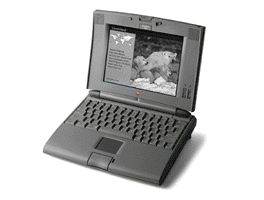 POWERBOOK 540
POWERBOOK 540CPU
CPU: Motorola MC68LC040
CPU Speed: 33 MHz
Bus Speed: 33 MHz
Data Path: 32 bit
ROM: 2 MB
RAM Type: unique
Minimum RAM Speed: 70 ns
Onboard RAM: 4 MB
RAM slots: 1
Maximum RAM: 36 MB
Level 1 Cache: 8 kB
Expansion Slots: modem, optional type II/III PC Card bay
Video
Screen: 9.5" active-matrix
Max Resolution: 8 bit grayscale 640x480
Video Out: 8 bit 832x624 (mirror only)
Storage
Hard Drive: 240-500 MB
Floppy Drive: 1.4 MB SuperDrive
Input/Output
ADB: 2
Serial: 1
SCSI: HDI-30
Audio Out: stereo 16 bit mini
Audio In: stereo 16 bit mini
Speaker: stereo
Microphone: mono
Networking
Ethernet: AAUI-15
Miscellaneous
Codename: BlackBird, SR-71, Spruce Goose
Gestalt ID: 72
Power: 40 Watts
Dimensions: 2.3" H x 11.5" W x 9.7" D
Weight: 7.1 lbs.
Minimum OS: 7.1.1
Maximum OS: 8.1
Introduced: May 1994
Terminated: October 1994
 For my birthday, a/g was kind and thoughtful enough to upgrade my flickr account to PRO status, thank you very much! (No more rationing of monthly uploads for me! Yay!) So tonight, to break 'er in, I uploaded some of my Taliesin West pictures (famed architect Frank Llyod Wright's Arizona home and school of architecture). I have many more to add to the set -- these are just a start. Flickr rocks. Thanks a/g. What a great gift.
For my birthday, a/g was kind and thoughtful enough to upgrade my flickr account to PRO status, thank you very much! (No more rationing of monthly uploads for me! Yay!) So tonight, to break 'er in, I uploaded some of my Taliesin West pictures (famed architect Frank Llyod Wright's Arizona home and school of architecture). I have many more to add to the set -- these are just a start. Flickr rocks. Thanks a/g. What a great gift.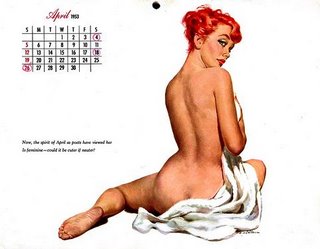 We are nearing the end of April '06, but it's not too late to feature Miss April, as she appeared in Esquire back in 1953. She is gorgeous, and beautifully illustrated by E. Chiriaka. For more on the Esquire calendar girls of yesteryear, and copious quantities of assorted retro illustrations, visit one of the best blogs ever (!): "Today's Inspiration."
We are nearing the end of April '06, but it's not too late to feature Miss April, as she appeared in Esquire back in 1953. She is gorgeous, and beautifully illustrated by E. Chiriaka. For more on the Esquire calendar girls of yesteryear, and copious quantities of assorted retro illustrations, visit one of the best blogs ever (!): "Today's Inspiration."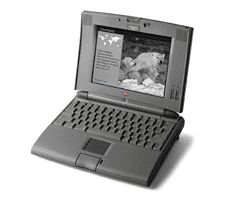 POWERBOOK 520
POWERBOOK 520CPU
CPU: Motorola MC68LC040
CPU Speed: 25 MHz
Bus Speed: 25 MHz
Data Path: 32 bit
ROM: 2 MB
RAM Type: unique
Minimum RAM Speed: 70 ns
Onboard RAM: 4 MB
RAM slots: 1
Maximum RAM: 36 MB
Level 1 Cache: 8 kB
Expansion Slots: modem, optional type II/III PC Card bay
Video
Screen: 9.5" passive matrix FSTN
Max Resolution: 4 bit grayscale 640x480
Storage
Hard Drive: 130-320 MB
Floppy Drive: 1.4 MB SuperDrive
Input/Output
ADB: 2
Serial: 1
SCSI: HDI-30
Audio Out: stereo 16 bit mini
Audio In: stereo 16 bit mini
Speaker: stereo
Microphone: mono
Networking
Ethernet: AAUI-15
Miscellaneous
Codename: BlackBird LC
Gestalt ID: 72
Power: 40 Watts
Dimensions: 2.3" H x 11.5" W x 9.7" D
Weight: 6.3 lbs.
Minimum OS: 7.1.1
Maximum OS: 8.1
Introduced: May 1994
Terminated: June 1995
 Remember when you pee'd & poo'd in v's brand new house the very 1st day we got you? A couple times over? Remember when you would pee on our bed in spite? When you pee'd on my Edward Gorey collector's pop-up book? When you came to work with me and scratched the hell out of a's office door and pee'd on the carpet? When you pee'd in the pool? When you barfed under our bed so profusely we had to buy a carpet steamer to clean it? When you got an intestinal infection from a lamb bone djedo slipped you and... well... made a significant, ungodly mess? When s & d went home to toronto and you cried and barfed in their room? When you cried so much in the night with a/g she had to go home to sleep? When you ate not 1, but 2 strands of icicle lights? When you chewed on the playstation cable? When you tore my bath-loofah-thingy into thousands of teeny shreds? When you tore my pretty skirt? When you pulled that tuft of hair out of that dog's back? When you wrapped yourself around that staffordshire's head and tried to pull his eyes out? When you used to lick the iguana? When you walked over a snake in the desert not knowing what it was? When you caught that bird in your mouth? When you ate all that rotini out of the garbage? When you ate a... erm... feminine hygiene product? When you ate a Cheweez beefy roll in one 30-minute sitting and slept like an anaconda who'd just swallowed an antelope for about 14 hours? Yay! All were good, good times. Happy 7th bday, little 'ro dog!
Remember when you pee'd & poo'd in v's brand new house the very 1st day we got you? A couple times over? Remember when you would pee on our bed in spite? When you pee'd on my Edward Gorey collector's pop-up book? When you came to work with me and scratched the hell out of a's office door and pee'd on the carpet? When you pee'd in the pool? When you barfed under our bed so profusely we had to buy a carpet steamer to clean it? When you got an intestinal infection from a lamb bone djedo slipped you and... well... made a significant, ungodly mess? When s & d went home to toronto and you cried and barfed in their room? When you cried so much in the night with a/g she had to go home to sleep? When you ate not 1, but 2 strands of icicle lights? When you chewed on the playstation cable? When you tore my bath-loofah-thingy into thousands of teeny shreds? When you tore my pretty skirt? When you pulled that tuft of hair out of that dog's back? When you wrapped yourself around that staffordshire's head and tried to pull his eyes out? When you used to lick the iguana? When you walked over a snake in the desert not knowing what it was? When you caught that bird in your mouth? When you ate all that rotini out of the garbage? When you ate a... erm... feminine hygiene product? When you ate a Cheweez beefy roll in one 30-minute sitting and slept like an anaconda who'd just swallowed an antelope for about 14 hours? Yay! All were good, good times. Happy 7th bday, little 'ro dog! Yesterday's sidebar drama had me hacking around in ih2b's template, and put me in the (obssesive compulsive) mood to tinker. I decided that this here blog, so close to it's 100th post, deserved a makeover. It's not quite done -- I still have to put in the site of the week & goody of the week links, my flickr badge, and a couple of other pre-existing features... and I'll be adding some new sidebar categories, too... so there's still quite a bit of futzing around to do. But that's to be expected, because, well you know, i do heart to blog! And should there be any glitches - and there well may be - please forgive them along the way!
Yesterday's sidebar drama had me hacking around in ih2b's template, and put me in the (obssesive compulsive) mood to tinker. I decided that this here blog, so close to it's 100th post, deserved a makeover. It's not quite done -- I still have to put in the site of the week & goody of the week links, my flickr badge, and a couple of other pre-existing features... and I'll be adding some new sidebar categories, too... so there's still quite a bit of futzing around to do. But that's to be expected, because, well you know, i do heart to blog! And should there be any glitches - and there well may be - please forgive them along the way! POWERMAC 6100
POWERMAC 6100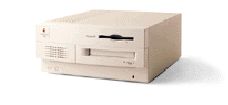 POWERMAC 7100
POWERMAC 7100"Introduced in March 1994, the PowerMac 7100 was a faster, more expandable, 6100. It came in a slightly restyled IIvx case, and was speed-bumped to 80 MHz in January 1995. It was originally priced at $2,900. (photo credit: Apple Computer)
This byte of Apple's history from Wired's, "30 Years of Apple Products."
He's gone to the south of my page for a wee trip of some kind. Perhaps he's bored with the right, or perhaps he's taking some sort of stand and retaliating against me, looking for some space. I'm not sure. But whatever the case, it's clear we're going to have to spend some quality time together until we sort through this problem. I'm comitted to sidebar though, and I vow to get him back where he belongs just as fast as I can. Feel free to take a jaunt down there to see him... just in case he's feeling lonely.
 NEWTON MESSAGE PAD 110
NEWTON MESSAGE PAD 110CPU
CPU: ARM 610
CPU Speed: 20 MHz
ROM: 4 MB
Onboard RAM: 1.0 MB
RAM slots: 0
Maximum RAM: 1.0 MB
Expansion Slots: 1 Type II PCMCIA
Video
Screen: reflective LCD
Max Resolution: 1 bit 320x240
Input/Output
Serial: 1
Speaker: mono
Networking
Modem: 9600 bps, optional
Miscellaneous
Codename: Lindy
Dimensions: 8" H x 4" W x 1.25" D
Weight: 1.28 lbs.
Minimum OS: Newton OS 1.3
Maximum OS: Newton OS 1.3
Introduced: March 1994
Terminated: April 1995
 I wanted to keep with the instructional theme of my "keyboard shortcuts" April desktop, so for May, I kept essentially the same layout, but added some handy css pointers this time (I'm trying to become more css savvy). I kept the amazing "Goodbye Sky" artwork along the sides by James Wignall, but modified it's colour balance to something a little more earthy. I switched up my background colour too, (with some inspiration from Pantone's Fashion Colour Report Spring 2006, thank you) and replaced last month's butterflies with Fruit icons by Monochrom. I couldn't resist putting in a pair of fabulous fishies from Colheres Pets icon set for good measure. It seemed like the right thing to do. I think it will serve me well this month.
I wanted to keep with the instructional theme of my "keyboard shortcuts" April desktop, so for May, I kept essentially the same layout, but added some handy css pointers this time (I'm trying to become more css savvy). I kept the amazing "Goodbye Sky" artwork along the sides by James Wignall, but modified it's colour balance to something a little more earthy. I switched up my background colour too, (with some inspiration from Pantone's Fashion Colour Report Spring 2006, thank you) and replaced last month's butterflies with Fruit icons by Monochrom. I couldn't resist putting in a pair of fabulous fishies from Colheres Pets icon set for good measure. It seemed like the right thing to do. I think it will serve me well this month. This is why i heart the internet so. There is just so much out there, that you never knew existed, or even fathomed would exist. But then you stumble upon it, quite by accident, and you think to yourself, "how delightful and how very fascinating that this should exist... Of course this should exist!" I Am Bored gives us an animated video for Radiohead's "Creep" because they can; because the internet is wonderful, and makes people want to create and bring unlikely things into existence if for no other reason than just to exist. And should you feel like singing along, please, just do so...
This is why i heart the internet so. There is just so much out there, that you never knew existed, or even fathomed would exist. But then you stumble upon it, quite by accident, and you think to yourself, "how delightful and how very fascinating that this should exist... Of course this should exist!" I Am Bored gives us an animated video for Radiohead's "Creep" because they can; because the internet is wonderful, and makes people want to create and bring unlikely things into existence if for no other reason than just to exist. And should you feel like singing along, please, just do so..."when you were here before / couldnt look you in the eye / youre just like an angel / your skin makes me cry / you float like a feather / in a beautiful world / and I wish was special / youre so f***ing special /// but Im a creep, Im a weirdo / what the hell am I doing here? / I dont belong here /// I dont care if it hurts / I want to have control / I want a perfect body / I want a perfect soul / I want you to notice / when Im not around / youre so f***ing special / I wish I was special /// but Im a creep, Im a weirdo / what the hell am I doing here? / I dont belong here /// shes running out again / shes running out / shes run run run running out... / whatever makes you happy / whatever you want / youre so f***ing special / I wish I was special... ///
but Im a creep, Im a weirdo / what the hell am I doing here? / I don't belong here..."
 MACINTOSH TV
MACINTOSH TVCPU
CPU: Motorola MC68030
CPU Speed: 32 MHz
FPU: 68882
Bus Speed: 16 MHz
Data Path: 32 bit
ROM: 1 MB
RAM Type: 72 pin SIMM
Minimum RAM Speed: 80 ns
Onboard RAM: 4 MB
RAM slots: 1
Maximum RAM: 36 MB
Level 1 Cache: 0.5 kB
Video
Monitor: 14" CRT (built-in)
Video Card/Chipset: tv-tuner card
VRAM: 512 kB
Max Resolution: 640x480
Storage
Hard Drive: 160 MB
Floppy Drive: 1.4 MB SuperDrive
Optical Drive: 2x CD-ROM
Input/Output
ADB: 2
Serial: 2
SCSI: DB-25
Audio Out: stereo 8 bit mini
Speaker: mono
Miscellaneous
Codename: Peter Pan, LD50
Gestalt ID: 88
Power: 60 Watts
Dimensions: 17.9" H x 13.5" W x 16.5" D
Weight: 40.5 lbs.
Minimum OS: 7.1
Maximum OS: 7.6.1
Introduced: October 1993
Terminated: February 1994
This byte of Apple's history from,"30 Years of Apple Products."
 I think of myself as primarily a print designer, even though I do dabble in a bit of web here & there. My web knowledge is admittedly pretty basic, but with the amount of reading I do on html, css, web 2.0, etc., I can confidently say I know a lot in theory (though not as much in actual practice). Well, theory only gets you so far -- and seeing as though css (cascading style sheets) is clearly the more efficient, flexible method of web page design, (even messing with this blog's template has given me some introductory insight), I decided today (yes, another slow day in the world of freelance), to read up on it at the "Web Page Design For Designers" site, while simultaneously creating my May desktop, featuring some oft used, basic css rules. I got through the first 7 sections, and while a lot of it reiterated what I already understood of css, it read incredibly well and was easy to follow -- more so than any other css tutorials I've encountered. If you're new to the world of web design, or css, or both -- you may want to check out this site. You're sure to learn a lot, even if only for theory's sake. And stay tuned for May's css-inspired desktop. I'm attempting to beautify it now, and hope to post it today or tomorrow.
I think of myself as primarily a print designer, even though I do dabble in a bit of web here & there. My web knowledge is admittedly pretty basic, but with the amount of reading I do on html, css, web 2.0, etc., I can confidently say I know a lot in theory (though not as much in actual practice). Well, theory only gets you so far -- and seeing as though css (cascading style sheets) is clearly the more efficient, flexible method of web page design, (even messing with this blog's template has given me some introductory insight), I decided today (yes, another slow day in the world of freelance), to read up on it at the "Web Page Design For Designers" site, while simultaneously creating my May desktop, featuring some oft used, basic css rules. I got through the first 7 sections, and while a lot of it reiterated what I already understood of css, it read incredibly well and was easy to follow -- more so than any other css tutorials I've encountered. If you're new to the world of web design, or css, or both -- you may want to check out this site. You're sure to learn a lot, even if only for theory's sake. And stay tuned for May's css-inspired desktop. I'm attempting to beautify it now, and hope to post it today or tomorrow. This morning's stumbling on the web lead me to UK-based, You Are Beautiful. It's a very nice body of work, indeed; and while the sports illustrations at the beginning almost lost me, I hung in there, kept clicking away, and found some, well, beautiful stuff. I heart that messy-bits-of-tape-and-smudged-ink look Kerry employs from time to time, and found the identity pieces to be particularily inspiring.
This morning's stumbling on the web lead me to UK-based, You Are Beautiful. It's a very nice body of work, indeed; and while the sports illustrations at the beginning almost lost me, I hung in there, kept clicking away, and found some, well, beautiful stuff. I heart that messy-bits-of-tape-and-smudged-ink look Kerry employs from time to time, and found the identity pieces to be particularily inspiring.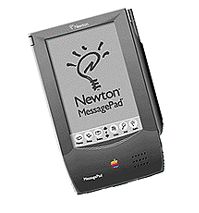 NEWTON MESSAGE PAD OMP
NEWTON MESSAGE PAD OMPCPU
CPU: ARM 610
CPU Speed: 20 MHz
ROM: 4 MB
Onboard RAM: 640 kB
RAM slots: 0
Maximum RAM: 640 kB
Expansion Slots: 1 Type II PCMCIA
Video
Screen: reflective LCD
Max Resolution: 1 bit 336x240
Input/Output
Serial: 1
Speaker: mono
Networking
Modem: 9600 bps, optional
Miscellaneous
Codename: Newton
Dimensions: 7.25" H x 4.50" W x 0.75" D
Weight: 0.9 lbs.
Minimum OS: Newton OS 1.0
Maximum OS: Newton OS 1.11
Introduced: August 1993
Terminated: March 1994
This byte of Apple's history from Wired's, "30 Years of Apple Products."
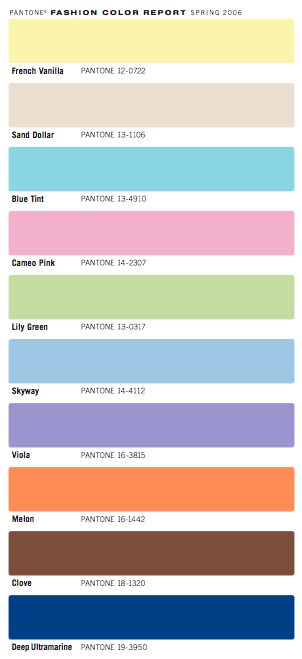

 Why did I choose Brian Rea's site as Site of The Week? Because I've always been a firm believer that Less Is More. You don't always have to be all flashy and have things move around and morph shape and colour while making little hi-tec sounds to get noticed. And his illustration style is so wonderfully... lo-fi. It's perfectly imperfect. One could conceivably argue that because his drawings are so simplistic and so unpolished that Rea has little talent, but his crude, seemingly unsophiticated technique tells me straightaway that he has oodles of it. And if upon viewing his work you still can't conclude what's so great about it.... check out his client list. Can you say, "laughing all the way to the bank?"
Why did I choose Brian Rea's site as Site of The Week? Because I've always been a firm believer that Less Is More. You don't always have to be all flashy and have things move around and morph shape and colour while making little hi-tec sounds to get noticed. And his illustration style is so wonderfully... lo-fi. It's perfectly imperfect. One could conceivably argue that because his drawings are so simplistic and so unpolished that Rea has little talent, but his crude, seemingly unsophiticated technique tells me straightaway that he has oodles of it. And if upon viewing his work you still can't conclude what's so great about it.... check out his client list. Can you say, "laughing all the way to the bank?" Thanks to the sage Quizilla's,"What Horrible Edward Gorey Death Will You Die?"quiz, I now know that I will die the death of fits, just like little Susan here. Hey, everyone has to go somehow.
Thanks to the sage Quizilla's,"What Horrible Edward Gorey Death Will You Die?"quiz, I now know that I will die the death of fits, just like little Susan here. Hey, everyone has to go somehow. MACINTOSH QUADRA 660av
MACINTOSH QUADRA 660avCPU
CPU: Motorola MC68040
CPU Speed: 25 MHz
FPU: integrated
Bus Speed: 25 MHz
Data Path: 32 bit
ROM: 2 MB
RAM Type: 72 pin SIMM
Minimum RAM Speed: 70 ns
Onboard RAM: 4 MB
RAM slots: 2
Maximum RAM: 68 MB
Level 1 Cache: 8 kB
Expansion Slots: 1 7" NuBus, 1 PDS
Video
VRAM: 1 MB
Max Resolution: 1152x870
Video Out: DB-15, s-video, composite
Video In: s-video, composite
Storage
Hard Drive: 160-320 MB
Floppy Drive: 1.4 MB SuperDrive
Optical Drive: optional
Input/Output
ADB: 1
Serial: 2
SCSI: DB-25
Audio Out: stereo 16 bit mini
Audio In: stereo 16 bit mini
Speaker: mono
Microphone: mono
Networking
Ethernet: AAUI-15
Miscellaneous
Codename: Tempest
Gestalt ID: 60
Power: 86 Watts
Dimensions: 3.4" H x 16.3" W x 15.6" D
Weight: 14 lbs.
Minimum OS: 7.1
Maximum OS: 8.1
Introduced: July 1993
Terminated: September 1994
previously on i heart to blog
- mother's my new mother now
- sunday scribblings - hi, my name is...
- the heart wants what it wants
- yeun hearts serenity now
- mmm... mStand
- photo friday 05•18•07 - large
- thursday challenge - motion
- eyes turned upward... on my desktop
- i heart linnea gits gifts
- photo friday 04•27•07 - relaxation
i heart archives
- 03.12.2006
- 03.19.2006
- 03.26.2006
- 04.02.2006
- 04.09.2006
- 04.16.2006
- 04.23.2006
- 04.30.2006
- 05.07.2006
- 05.14.2006
- 05.21.2006
- 05.28.2006
- 06.04.2006
- 06.11.2006
- 06.18.2006
- 06.25.2006
- 07.02.2006
- 07.09.2006
- 07.16.2006
- 07.23.2006
- 07.30.2006
- 08.13.2006
- 08.20.2006
- 08.27.2006
- 09.17.2006
- 10.08.2006
- 10.15.2006
- 11.05.2006
- 11.19.2006
- 12.03.2006
- 12.17.2006
- 01.07.2007
- 02.11.2007
- 02.18.2007
- 03.11.2007
- 03.18.2007
- 03.25.2007
- 04.01.2007
- 04.08.2007
- 04.15.2007
- 04.22.2007
- 05.13.2007
- 05.27.2007
- 07.08.2007
- 09.23.2007
- 10.07.2007
i heart site picks
- the skinny
- stuck in the 80's
- candykiller
- misprinted type
- gigposters.com
- juju's delivery service
- j. otto seibold
- the creative bushido
- thinking with type
- brian rea
- bizart
- just for the F of it
- pixel gasoline
- chromasia
- no! spec
i heart goodies
- veer activity books
- dark horse buffy desktop
- i heart 80's videos
- 50 AIGA symbols
- free site?
- culture fool challenge
- essence of rabbit
- j. otto's bubblesoap
- grandPerspective
- behind the typeface: cooper black
- pantone spring color report
- brilliant button maker
- fuse fun bouncy ball
- monochrom
- 25 best free fonts
- moccu e-cards
i heart working for
i heart these daily
i heart & want to marry
- iso50
- moccu
- s. britt
- so fake
- grotesk
- otterball
- four5one
- candy killer
- fiona hewitt
- sky and snow
- homestarrunner
- charles s. anderson
- design bureau of amerika
i heart thursday challenge
i heart photo friday
- relaxation
- heat
- remarkable
- health
- automotive
- home
- masterpiece
- adolescence
- famous
- golden
- postsecret
- china 2006
- the apple blog
- doing it to death
- all about the pretty
- le moleskine à beleg
- papeis por todo o lado
- secret life of shi sensei
- tamar graphics connection
i heart sunday scribblings
i heart blogworthiness
i heart procrastinating
i heart heavy rotation
i heart books on the go
i heart to covet
- EQ3
- moo
- lush
- (RED)
- relish
- holga
- ugly dolls
- matt & nat
- miso pretty
- sugar paper
- lovely design
- the cupcake shoppe
- pantone flight stools
- wallpaper from the 70's
- red maloo laptop sleeves
i heart learning css
- css vault
- css import
- css beauty
- css lookup
- 10 css tricks
- css examples
- css bookmarks
- css try it editor
- max design css
- css zen garden
- mandarin design
- holy css zeldman
- eric meyer on css
- brainjar css positioning
- css from the ground up
- css web design from scratch

a t o m . 0 . 3


